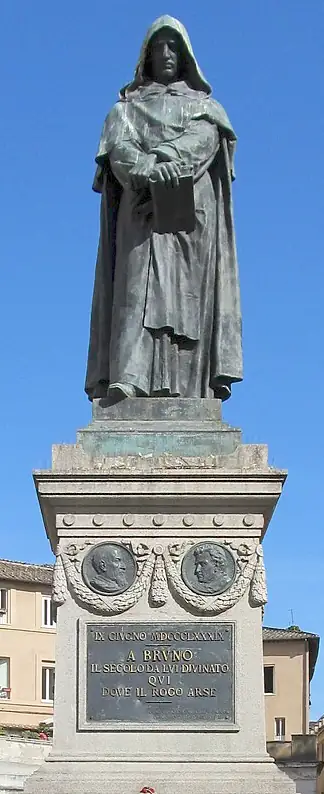136 years ago, a monument to Giordano Bruno was unveiled in the heart of Rome. Bruno had been burned at the stake by the Inquisition in 1600 for his belief in the spatial and temporal infinity of the cosmos and for his pantheistic views. The Pope felt provoked and threatened to leave Rome. It wasn’t until 2000 that Pope John Paul II declared Bruno’s execution unjust, though he did not rehabilitate him.

The Campo de’ Fiori is decorated with many colorful flags. Large plaques surround the square, inscribed with quotes from Bruno, such as, “With greater fear you pronounce judgment upon me than I hear it.” The monument to the philosopher from Nola is unveiled. The philosopher is depicted in a Dominican robe, a book in his hands, his hood pulled over his face, pensive and absorbed, his expression one of austerity emphasized by the bronze of the statue. The inscription reads: “To Bruno, the century he foretold here, where the pyre burned.”
At 9 a.m., a procession begins from Piazza Esedra (now Piazza della Repubblica). According to Catholic newspapers, there are fewer than five thousand participants, while “Il Messaggero” reports twenty thousand. At the head of the procession are Garibaldi veterans, followed by the rector and professors of the University of Rome, representatives of foreign universities, representatives of the city government including the mayor of Rome, Augusto Armellini (whose father had been a Triumvir of the Roman Republic in 1849), associations from Nola (Giordano Bruno’s birthplace), Freemason lodges, and members of the Chamber of Deputies.
The procession, which proceeds along the Via Nazionale and through the Piazza Venezia to the Campo de’ Fiori, is greeted with great enthusiasm by the Romans. The official speaker at the ceremony is the Republican Giovanni Bovio, a deputy since 1876. At the end of the ceremony, the procession moves to the Capitoline Hill to pay homage to the bust of Garibaldi.
A memorable day for Rome, a black day for the clergy. The Pope, who had threatened to evacuate the capital if the monument were unveiled, spent the day fasting and prostrate before the statue of Saint Peter, while, in his words, “the revolutionary Hydra raged through the streets of the city.”
On June 29, the feast day of Saints Peter and Paul, expiatory masses are celebrated in all the churches of Rome, and the Roman aristocracy attends a mass in St. Peter’s Basilica. On June 30, Pope Leo XIII condemns the insult to the Church and considers the bronze statue of Bruno a symbol of “a merciless struggle against the Catholic religion.”
“Civiltà cattolica,” the Jesuit journal that spearheaded the attack on the modern world, writes that the statue of Bruno “marks the triumph of the rabbis of the synagogue, the archimandrites of Freemasonry, and the leaders of demagogic liberalism.” Therefore, the Campo de’ Fiori square must be “renamed Campo Maledetto (Cursed Square) until a chapel of atonement for the Sacred Heart of Jesus is erected in place of the monument.”
___
Source: Periodico del Libero Pensiero „Giordano Bruno”, Dr. Paolo Cimarelli


